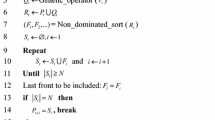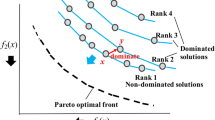Abstract
Dominance resistance is a challenge for Pareto-based multi-objective evolutionary algorithms to solve the high-dimensional optimization problems. The Non-dominated Sorting Genetic Algorithm III (NSGA-III) still has such disadvantage even though it is recognized as an algorithm with good performance for many-objective problems. Thus, a variation of NSGA-III algorithm based on fine final level selection is proposed to improve convergence. The fine final level selection is designed in this way. The θ-dominance relation is used to sort the solutions in the critical layer firstly. Then ISDE index and favor convergence are employed to evaluate convergence of individuals for different situations. And some better solutions are selected finally. The effectiveness of our proposed algorithm is validated by comparing with nine state-of-the-art algorithms on the Deb-Thiele-Laumanns-Zitzler and Walking-Fish-Group test suits. And the optimization objectives are varying from 3 to 15. The performance is evaluated by the inverted generational distance (IGD), hypervolume (HV), generational distance (GD). The simulation results show that the proposed algorithm has an average improvement of 55.4%, 60.0%, 63.1% of 65 test instances for IGD, HV, GD indexes over the original NSGA-III algorithm. Besides, the proposed algorithm obtains the best performance by comparing 9 state-of-art algorithms in HV, GD indexes and ranks third for IGD indicator. Therefore, the proposed algorithm can achieve the advantages over the benchmarks.








Similar content being viewed by others
References
Li B, Li J, Tang K, Yao X (2015) Many-objective evolutionary algorithms: a survey. ACM Comput Surv 48(1):1–35. https://doi.org/10.1145/2792984
Fu G, Kapelan Z, Kasprzyk JR, Reed P (2013) Optimal design of water distribution systems using many-objective visual analytics. J Water Resour Plan Manag 139(6):624–633. https://doi.org/10.1061/(asce)wr.1943-5452.0000311
Zhu Y, Liang J, Chen J, Ming Z (2017) An improved NSGA-III algorithm for feature selection used in intrusion detection. Knowl-Based Syst 116:74–85
Zulvia FE, Kuo RJ, Nugroho DY (2020) A many-objective gradient evolution algorithm for solving a green vehicle routing problem with time windows and time dependency for perishable products. J Clean Prod 242:118428
Li K, Deb K, Zhang Q, Kwong S (2014) An evolutionary many-objective optimization algorithm based on dominance and decomposition. IEEE Trans Evol Comput 19(5):694–716
Zheng W, Tan Y, Meng L, Zhang H (2018) An improved MOEA/D design for many-objective optimization problems. Appl Intell 48(10):3839–3861
Asafuddoula M, Ray T, Sarker R (2014) A decomposition-based evolutionary algorithm for many objective optimization. IEEE Trans Evol Comput 19(3):445–460
Wang R, Zhou Z, Ishibuchi H, Liao T, Zhang T (2016) Localized weighted sum method for many-objective optimization. IEEE Trans Evol Comput 22(1):3–18
Li B, Tang K, Li J, Yao X (2016) Stochastic ranking algorithm for many-objective optimization based on multiple indicators. IEEE Trans Evol Comput 20(6):924–938
Pamulapati T, Mallipeddi R, Suganthan PN (2018) $ I_ {\text SDE} $+—an Indicator for multi and many-objective optimization. IEEE Trans Evol Comput 23(2):346–352
Yuan Y, Xu H, Wang B, Zhang B, Yao X (2015) Balancing convergence and diversity in decomposition-based many-objective optimizers. IEEE Trans Evol Comput 20(2):180–198
Jiang S, Yang S (2017) A strength Pareto evolutionary algorithm based on reference direction for multiobjective and many-objective optimization. IEEE Trans Evol Comput 21(3):329–346
Palakonda V, Mallipeddi R (2017) Pareto dominance-based algorithms with ranking methods for many-objective optimization. IEEE Access 5:11043–11053
Yang S, Li M, Liu X, Zheng J (2013) A grid-based evolutionary algorithm for many-objective optimization. IEEE Trans Evol Comput 17(5):721–736
Yuan Y, Xu H, Wang B, Yao X (2015) A new dominance relation-based evolutionary algorithm for many-objective optimization. IEEE Trans Evol Comput 20(1):16–37
He Z, Yen GG, Zhang J (2013) Fuzzy-based Pareto optimality for many-objective evolutionary algorithms. IEEE Trans Evol Comput 18(2):269–285
Liu Y, Zhu N, Li K, Li M, Zheng J, Li K (2020) An angle dominance criterion for evolutionary many-objective optimization. Inf Sci 509:376–399
Bao C, Xu L, Goodman ED (2019) A new dominance-relation metric balancing convergence and diversity in multi-and many-objective optimization. Expert Syst Appl 134:14–27
Beume N, Naujoks B, Emmerich M (2007) SMS-EMOA: multiobjective selection based on dominated hypervolume. Eur J Oper Res 181(3):1653–1669
Li F, Cheng R, Liu J, Jin Y (2018) A two-stage R2 indicator based evolutionary algorithm for many-objective optimization. Appl Soft Comput 67:245–260
Sun Y, Yen GG, Yi Z (2018) IGD indicator-based evolutionary algorithm for many-objective optimization problems. IEEE Trans Evol Comput 23(2):173–187
Deb K, Pratap A, Agarwal S, Meyarivan T (2002) A fast and elitist multiobjective genetic algorithm: NSGA-II. IEEE Trans Evol Comput 6(2):182–197
Li M, Yang S, Liu X (2013) Shift-based density estimation for Pareto-based algorithms in many-objective optimization. IEEE Trans Evol Comput 18(3):348–365
Cai X, Sun H, Fan Z (2018) A diversity indicator based on reference vectors for many-objective optimization. Inf Sci 430:467–486
Wang H, Jiao L, Yao X (2014) Two_Arch2: An improved two-archive algorithm for many-objective optimization. IEEE Trans Evol Comput 19(4):524–541
Lin Q, Liu S, Wong K-C, Gong M, Coello CAC, Chen J, Zhang J (2018) A clustering-based evolutionary algorithm for many-objective optimization problems. IEEE Trans Evol Comput 23(3):391–405
Dai G, Zhou C, Wang M, Li X (2018) Indicator and reference points co-guided evolutionary algorithm for many-objective optimization problems. Knowl-Based Syst 140:50–63
Liu C, Zhao Q, Yan B, Elsayed S, Ray T, Sarker R (2018) Adaptive sorting-based evolutionary algorithm for many-objective optimization. IEEE Trans Evol Comput 23(2):247–257
Sun Y, Xue B, Zhang M, Yen GG (2018) A new two-stage evolutionary algorithm for many-objective optimization. IEEE Trans Evol Comput 23(5):748–761
Xu H, Zeng W, Zeng X, Yen GG (2018) An evolutionary algorithm based on Minkowski distance for many-objective optimization. IEEE Trans Cybern 49(11):3968–3979
Deb K, Jain H (2013) An evolutionary many-objective optimization algorithm using reference-point-based nondominated sorting approach, part I: solving problems with box constraints. IEEE Trans Evol Comput 18(4):577–601
Jain H, Deb K (2013) An evolutionary many-objective optimization algorithm using reference-point based nondominated sorting approach, part II: handling constraints and extending to an adaptive approach. IEEE Trans Evol Comput 18(4):602–622
Cai L, Qu S, Yuan Y, Yao X (2015) A clustering-ranking method for many-objective optimization. Appl Soft Comput 35:681–694
Ding R, Dong H, He J, Li T (2019) A novel two-archive strategy for evolutionary many-objective optimization algorithm based on reference points. Appl Soft Comput 78:447–464
Cui Z, Chang Y, Zhang J, Cai X, Zhang W (2019) Improved NSGA-III with selection-and-elimination operator. Swarm Evol Comput 49:23–33
Elarbi M, Bechikh S, Said LB (2018) On the importance of isolated infeasible solutions in the many-objective constrained NSGA-III. Knowl-Based Syst 104335. https://doi.org/10.1016/j.knosys.2018.05.015
Yi J-H, Deb S, Dong J, Alavi AH, Wang G-G (2018) An improved NSGA-III algorithm with adaptive mutation operator for big data optimization problems. Futur Gener Comput Syst 88:571–585
Tavana M, Li Z, Mobin M, Komaki M, Teymourian E (2016) Multi-objective control chart design optimization using NSGA-III and MOPSO enhanced with DEA and TOPSIS. Expert Syst Appl 50:17–39
Bi X, Wang C (2018) A niche-elimination operation based NSGA-III algorithm for many-objective optimization. Appl Intell 48(1):118–141
Bi X, Wang C (2017) An improved NSGA-III algorithm based on elimination operator for many-objective optimization. Memetic Computing 9(4):361–383
Cheng J, Yen GG, Zhang G (2015) A many-objective evolutionary algorithm with enhanced mating and environmental selections. IEEE Trans Evol Comput 19(4):592–605
Deb K, Thiele L, Laumanns M, Zitzler E (2005) Scalable test problems for evolutionary multiobjective optimization. Evolutionary multiobjective optimization. Springer, In, pp 105–145. https://doi.org/10.1007/1-84628-137-7_6
Huband S, Hingston P, Barone L, While L (2006) A review of multiobjective test problems and a scalable test problem toolkit. IEEE Trans Evol Comput 10(5):477–506
Chen H, Tian Y, Pedrycz W, Wu G, Wang R, Wang L (2019) Hyperplane assisted evolutionary algorithm for many-objective optimization problems. IEEE transactions on cybernetics, Hyperplane Assisted Evolutionary Algorithm for Many-Objective Optimization Problems
Elarbi M, Bechikh S, Gupta A, Said LB, Ong Y-S (2017) A new decomposition-based NSGA-II for many-objective optimization. IEEE Trans Syst, Man, Cybernetics: Syst 48(7):1191–1210
Cheng R, Jin Y, Olhofer M, Sendhoff B (2016) A reference vector guided evolutionary algorithm for many-objective optimization. IEEE Trans Evol Comput 20(5):773–791. https://doi.org/10.1109/tevc.2016.2519378
Liu Y, Gong D, Sun J, Jin Y (2017) A many-objective evolutionary algorithm using a one-by-one selection strategy. IEEE Trans Cybernet 47(9):2689–2702
Xiang Y, Zhou Y, Li M, Chen Z (2016) A vector angle-based evolutionary algorithm for unconstrained many-objective optimization. IEEE Trans Evol Comput 21(1):131–152
Coello CAC, Cortés NC (2005) Solving multiobjective optimization problems using an artificial immune system. Genet Program Evolvable Mach 6(2):163–190
Zitzler E, Thiele L (1999) Multiobjective evolutionary algorithms: a comparative case study and the strength Pareto approach. IEEE Trans Evol Comput 3(4):257–271
Van Veldhuizen DA (1999) Multiobjective evolutionary algorithms: classifications, analyses, and new innovations. Air Force Inst Tech Wright-Pattersonafb oh School of Eng
tian y, cheng r, Zhang X, Jin Y (2017) PlatEMO: a MATLAB platform for evolutionary multi-objective optimization [educational forum]. IEEE Comput Intell Mag 12(4):73–87
Derrac J, García S, Molina D, Herrera F (2011) A practical tutorial on the use of nonparametric statistical tests as a methodology for comparing evolutionary and swarm intelligence algorithms. Swarm Evol Comput 1(1):3–18
Acknowledgments
This work was supported by the National Natural Science Foundation of China [Grant No.51774228].
Author information
Authors and Affiliations
Corresponding author
Additional information
Publisher’s note
Springer Nature remains neutral with regard to jurisdictional claims in published maps and institutional affiliations.
Appendix 1
Appendix 1
Rights and permissions
About this article
Cite this article
Gu, Q., Wang, R., Xie, H. et al. Modified non-dominated sorting genetic algorithm III with fine final level selection. Appl Intell 51, 4236–4269 (2021). https://doi.org/10.1007/s10489-020-02053-z
Accepted:
Published:
Issue Date:
DOI: https://doi.org/10.1007/s10489-020-02053-z




